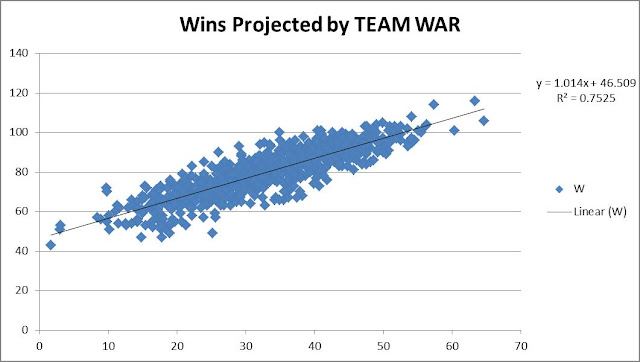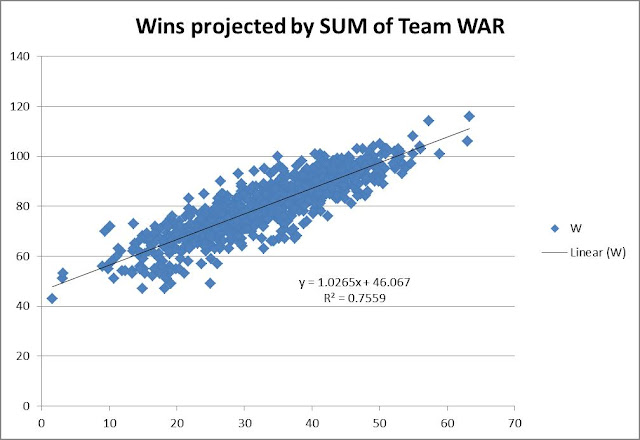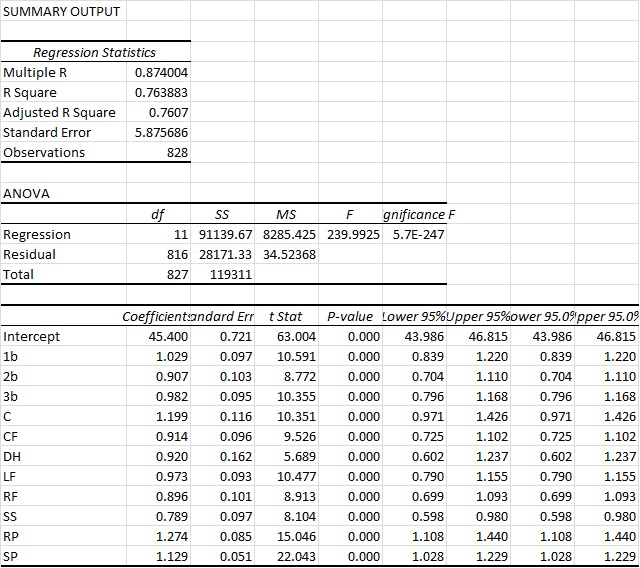2016 Composite Projections: Everything in One Place
Behold! A grotesquely indulgent spreadsheet.
In order to circumvent my rambling and better understand anything in the table you may find mystifying, skip down the page until you see the link for the spreadsheet again…
In Kyle Kinane’s 2010 stand-up set, which is immortalized in listenable format under the title, “Death of the Party”, he delivers his despondent outlook on life like a brilliant, seemingly drunk poet. There is a specific passage in which he speaks to his self-worth as it relates to his time spent as a gourmet cake decorations salesman; he refers to himself as:
“a stripped-bare toothless cog spinning freely and ineffectually in the working machine of society.”
Magnifique! As bleak as that is, I’m sure most of us have felt that way at one point or another – and not just about our jobs. As I grow older, I’ll be 31 this year; I find it harder to separate anything I do from a bigger scale, which of course leads to bouts of nihilism and depression; which leads to imaginary scenarios of myself never allowing my son to believe in Santa Claus – which is just anxiety over the idea of being a bad parent coupled with a dash of hopelessness about my existence. Looking back on my life sometimes yields the same results. I’ve spent an insane amount of my life’s time playing, watching, predicting, thinking about, and listening to baseball. We could say that it’s a strange existence, but then I guess you could say that about anything.
But man! Making this spreadsheet every year (mainly) at work really makes me feel like a ne’er-do-well. I’ve become so hyper focused I tune out co-workers and sometimes I feel like it’s brought on Asperger’s-like symptoms. For these reasons, this is probably the last time I’ll be doing this, albeit the first time I’m sharing this with other people.
My own projections started out (years ago) incredibly optimistic, as fans’ projections are wont to be and while I’ve refined them, and I really do love to do them. However, I realized that in a world with Steamer, ZiPS, and PECOTA, among others, the best results are yielded from a composite projection system (I’ve won my main league five of the last seven years using this system with no finishes outside the top three).
The systems used to create this Composite Projections System include:
Steamer, ZiPS, PECOTA, Marcell, Rotochamp, ESPN, my own projections, previous year performance (2015), a three-year average stat line, and for players with limited or no MLB experience, high-level minors numbers are regressed and thrown in as well.
I understand using 2015 and past three-year average is a little redundant as it’s baked into almost all the projection systems, but I do it because those numbers aren’t regressed in any way.
Let it be noted that a lot of the work on this spreadsheet isn’t mine. It’s an amalgamation of many different sites, authors, and ideas. I’ll try to parse it out for you the best I can and hopefully you can find it usable.
The first two rows are the headers – the first row is for hitters and the second row is for pitchers.
Hitters:
For the hitters, you should recognize all the stats until FAVG (Column AC). It’s a crude quotient and it stands for Fantasy Average. It really only provides value over larger sample sizes if it even provides any value at all. I like to use it to compare players that may end up with similar lines at the end of the season (Cespedes, A. Jones, C. Gonzalez) or players who have played in parts of the last couple seasons (Justin Turner).
The equation for hitters is simply:
(Hits + Runs + Home Runs + RBI + Stolen Bases) / At-Bats
Since all offensive stats are weighted equally, there’s a ton wrong with this, but generally speaking their can be a few tiers:
Tier 1: .700+ FAVG: elite offensive production, likely from a number-three hitter. (Only Trout, Goldschmidt, Stanton, McCutchen, M. Cabrera, Bautista, and Encarnacion occupy this tier as an average score over the last three years.)
Tier 2: .650 – .699: Usually players that make up rounds 2 – 3. 20/20 players or players with monster power.
Tier 3: .600 – .649: Players that excel in maybe 2 – 3 categories. It’s likely to be HR/RBI guys that either score a lot of runs or hit for a decent average as well. Less likely to be the super speedy guys, but if they score runs and add somewhere close to 10 – 15 HR, they’ll be here – think Altuve, Cain, Blackmon types.
Tier 4: .550 – .599: Here are the speedy players like Dee Gordon (though he may have moved up to the next tier by now. Solid players inhabit this realm, too.
Tier 5: .500 – .549: Catchers probably. Or single skill players, and bottom of the lineup dudes.
Tier 6: .499 and below: steer clear.
Column AD is titled ZIMM and it’s yanked directly from Jeff Zimmerman’s Draft Prep article from 2015. It’s actually a series of three posts and I did not run any positional adjustments for my table. The only other difference is that I used 5.9 as my adjusted slope for SB so that stolen bases aren’t so heavily valued – although that may be a mistake on my part due to the depressed stolen base environment in MLB.
Moving over one column to the right, R.R. stands for Roster Resource, and the numerical value signifies the projected lineup spot for each player. If they are on the DL, I have provided with where I think a player will be slotted once he returns from injury. If they are a back-up or are going to start in the minors it will say BE for Bench, or AAA (despite what level they might start at).
2Pos is just a column to denote second-position eligibility, which is why it is empty for most hitters.
The next five columns are lifted directly from Fantasy Pros‘ Average ADP page. This is the recommended way to sort these rankings as the default (column A) is set to my current rankings.
Now we see FAVG and ZIMM again, followed by more stats. These are all representative of a player’s average production over the past three years.
The headers for the colorful sections should be self-explanatory. The cells coated green are skills that are exactly at, or above league average. The more green cells the better, obviously. The reports were exported from FanGraphs except for the exit velocity data (columns CD – CJ), which I pulled from Baseball Savant.
Pitchers:
The first thing we’ll run into that looks strange is A. Score. This column rips data from Eno Sarris’ Arsenal Scores series. If a pitcher’s arsenal score was not available in his table for 2015, I went back and took them from the 2014 installment.
FAVG for Pitchers:
(Innings Pitched – Hits – Earned Runs – Walks + Strikeouts + Wins + Saves) / Innings Pitched
As with hitters, this works better with more information. There’s also the caveat that starters and relievers cannot be compared.
Tier Kershaw: Clayton Kershaw – he’s the only starter with an average FAVG of over 1.00 over the last three years.
Starter Tiers
Tier 1: .800 – .999 – it’s mainly Scherzer and Sale, although players will jump in and out of this tier (as with others).
Tier 2: .700 – .899 – While the term is vague, these guys are still fantasy aces.
Tier 3: .600 – .699 – fringe ace guys, or perceived aces.
Tier 4: .550 – .599 – pitchers with above average K rates, but not elite numbers.
Tier 5: .300 – .549 – either more contact oriented starters, or good K guys who have a bit of a free-pass issue. It’s a bigger net because wins are so unpredictable. We’re still top 70 type guys though.
Tier 6: There are still a ton of serviceable pitchers here and even below…like I said this is a crude stat.
Relief pitchers are much different and even non-closers tend to post rates above 1 – it’s a poor bell weather for relievers due to the high variance in role.
Moving on – the ZIMM score here directly reflects Jeff Zimmerman’s equation.
The Roster Resource feature shows what rotation spot pitchers will occupy and is pretty meaningless.
Off RS/G stands for Offense Runs Scored per game and I took these values from the projected standings page at FanGraphs. Wins are still, for the most part, unpredictable, but a good supporting offense definitely doesn’t hurt.
The next thing included that could be ambiguous is at the tail end of the three-year-average section (Columns AZ – BB). These indicate quality starts, quality start percentage, and game scores. Game scores aren’t really thought about too much, but if you sort the spreadsheet for pitchers by AVG game score, it’s a pretty good indicator of where they should be drafted.
Then of course it’s the comparison against league average section – again, the more green cells the better.
I really hope you find something helpful in this sheet. I know it’s pretty packed, but if you take a couple minutes to figure it out, you’ll find that almost everything you need is in there (no auction calculator or dollar values), so it’s pretty convenient.
Plus if you find value in it, maybe I’ll let my son believe in Santa Claus.




